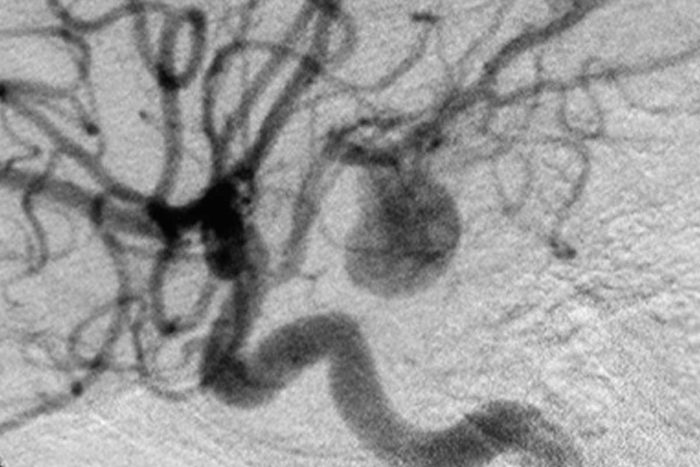Device offers innovative treatment of cerebral aneurysms
A new device helps heal difficult-to-treat aneurysms

Cerebral aneurysm. Image courtesy of Wikimedia Commons.
Washington University physicians are using a new technology, known as a PipelineTM embolization device, a device that crosses the neck of an aneurysm, diverting blood flow from the aneurysm cavity. Cerebral aneurysms are blood-filled balloon-like bulges in the wall of a blood vessel in the brain.
“This is going to change the paradigm for the way we treat many aneurysms,” says Christopher Moran, MD, professor of radiology and of neurological surgery.
Daniel Tubb, MD, an Oklahoma physician who retired last year, was shopping for glasses for the first time in seven years when he found he had lost a portion of the vision in his right eye. Appointments with a neuro-ophthalmologist and a neurosurgeon revealed that he had an aneurysm that was pressing on his optic nerves. Tubb came to Barnes-Jewish Hospital in April for placement of the new device.
“For me, there was no other treatment available — this was the only decent option,” Tubb says.
Not treatable with traditional methods
Aneurysms like Tubb’s are not treatable with traditional methods of surgical clipping or coiling. If the mouth of the aneurysm is particularly wide, physicians must insert a stent to keep the coil from partially or completely slipping back out of the aneurysm.
Previously, physicians used a stent with a cylindrical structure made of a metal mesh devised to line the interior wall of the blood vessel.
PipelineTM devices are similar to earlier stents, but the meshwork that comprises the Pipeline device has significantly smaller pores, blocking blood flow through the device into the aneurysm. This makes coil insertion unnecessary.

“This new device allows blood to clot within the aneurysm, which is followed by the development of fibrous tissue in response to the clot,” Moran says. “Finally, the blood vessel regrows its interior lining and seals off the aneurysm, which then naturally shrinks and disappears.”
Potential risks of PipelineTM stents include the formation of a clot within the device, which could close off the artery and cause a stroke. Careful monitoring and adjustment of clotting rates helps avoid this risk, according to Moran.
“This device, which lines the blood vessel, gives us a way to move from filling the aneurysm to actually repairing the blood vessel. It also reduces treatment risks by lessening patient radiation exposure,” Moran says.
Editor’s Note: Washington University radiologist Christopher Moran, MD, is a paid consultant for EV3, maker of the Pipeline embolization device.







